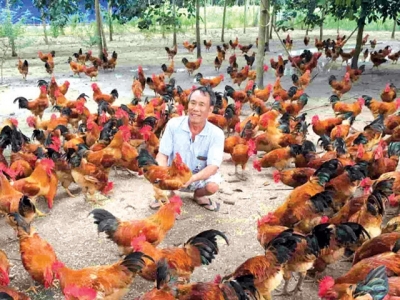Meat imports threaten domestic livestock industry

To improve their competitiveness, Vietnamese livestock companies have been told to restructure their production and supply chains.
According to the General Department of Customs (GDC), Vietnam spent $527 million to import poultry and animal meat in 2017.
Low prices have boosted imports in recent years. One kilo of pork is imported at $1.2, or VND27,000. Vietnam’s live pigs are sold at VND26,000 per kilogram.
Imported beef is also cheap. Australia sourced beef wholesales at VND60,000-120,000 per kilo and retails at VND165,000-200,000 per kilo. Vietnam’s beef has an average selling price of VND250,000 per kilo.
Chicken imports from the US, Brazil and South Korea sometimes were sold at $0.88 per kilo only, or VND20,000.
Imported beef is also cheap. Australia sourced beef wholesales at VND60,000-120,000 per kilo and retails at VND165,000-200,000 per kilo. Vietnam’s beef has an average selling price of VND250,000 per kilo.
Le Ba Lich, chair of the Vietnam Feed Association, said that imported meat is cheap because export countries have highly specialized and automated livestock industries.
The farming is developed in closed chains and is large scale with all phases strictly controlled.
In Vietnam, nearly all input materials come from imports, from breeders to feed to medicine. As a result, the farming costs are always high.
At present, poultry and animal meat imports still bear tax, but are putting pressure on domestic products. The pressure will be even worse when Vietnam fully implements FTA commitments and slashes the import tariff to zero percent.
According to Nguyen Dang Vang, chair of the Vietnam Livestock Association, the best solution for the livestock industry to become competitive is to develop closed farming chains.
A closed farming chain is used at CP Vietnam. Soon after setting foot in Vietnam, CP made heavy investments in feed production to gain a big share in the feed market. This was believed to be a wise move, as feed amounted to 65-70 percent of total farming cost.
After that, CP Vietnam built a number of fowl breeder farms. It has also been developing a distribution network with shops opened in many cities and provinces which sell products directly to customers.
Holding 40 percent of market share, CP Vietnam said that it is not afraid of imports.
Meanwhile, Bel Ga, De Heus and San Ha have joined forces to develop a closed fowl farming chain. In the chain, De Heus is in charge of providing feed, while Bel Ga is in charge of providing high-quality breeders to farms and San Ha is responsible for sales.
A closed farming chain also helped Vissan’s products compete well with imports.
Related news
 Fruit expansion plan continues
Fruit expansion plan continues The Tân Thành Hi-tech Agricultural Co-operative in Long An Province’s Thủ Thừa District has said it will continue to expand cultivation of custard apple, dragon
 CLRRI transfers new rice varieties to Loc Troi Group
CLRRI transfers new rice varieties to Loc Troi Group OM 9577, a high-yield rice variety, is highly resistant to salinity at 0.4% concentration and a short duration of 100-107 days, and brown plant hoppers and rice
 Pig farmers fight foreign competition
Pig farmers fight foreign competition The ratio of individual livestock farmers has significantly declined in the southern province of Đồng Nai in the past two years, with foreign-invested companies